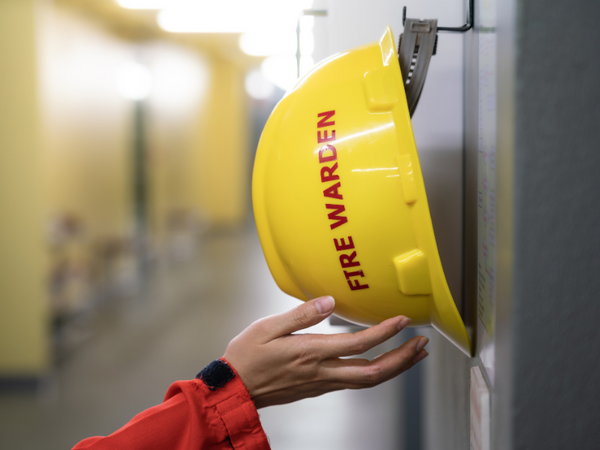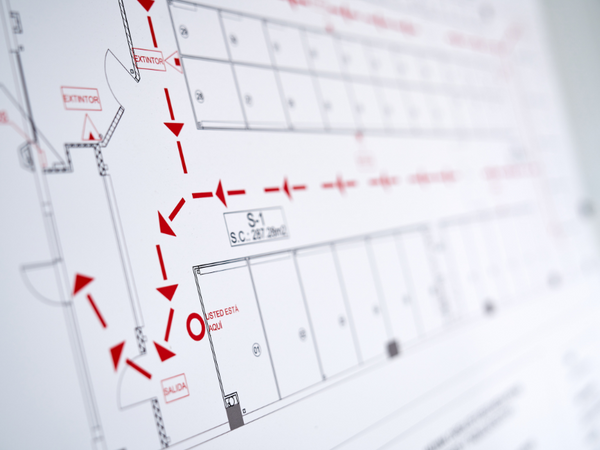Where you put your smoke detectors matters just as much as installing them. Proper placement makes sure they can detect...
A fire prevention plan isn't just about responding to emergencies. It starts with being ready to deal with the fire. Plus, it helps you spot the risks and put safety measures in place to make sure your team knows what to do if a fire breaks out.
In this guide, we’ll talk about what your fire prevention plan needs to include, why it needs to be in writing, and more.
Does the Fire Prevention Plan Need to Be In Writing?

Yes, a fire prevention plan needs to be in writing. The OSHA (Occupational Safety and Health Administration) requires written plans to be kept at the workplace and available for employees to review anytime. But there’s one exception: if a company has 10 or fewer employees, the plan can be shared verbally instead. Even then, it still needs to be available in the workplace.
A written fire prevention plan should include major fire hazards, how to handle or store them, what could spark a fire, and how to control those risks. It should also mention fire protection gear like fire blankets and fire sprays, who maintains that gear, and how fuel sources are managed safely.
In short, having a written plan makes things clearer. It helps everyone know what to do, prevents panic, and gives a solid reference for training or emergencies.
What Are the Requirements of a Fire Prevention Plan?

Creating a fire prevention plan isn’t just about checking boxes. It’s about keeping your workplace safe. Here’s what every solid plan should include to help stop fires before they spread and protect everyone inside:
1. Fire Hazards
-
List of major fire hazards: This includes anything that is flammable, such as liquids, gases, paper, wood, or chemicals.
-
Hazardous material handling and storage: Your plan should explain how to store and handle these materials safely.
-
Ignition sources: List things that could start and spread a fire. These include open flames, faulty wiring, hot work areas, or smoking zones.
-
Control measures: Add steps to lower the chance of a fire starting. These include routine inspections, keeping flammable items away from heat sources, and making sure no-smoking policies are followed.
2. Safe Practices and Procedures
-
Handling and storage: Show the proper way to use and keep flammable materials to help prevent fires.
-
Waste disposal: Make sure flammable waste is thrown away safely, preferably in tightly closed metal containers.
-
Housekeeping: Keep things tidy. Clutter, blocked exits, and messy storage can all become fire hazards.
-
Maintenance procedures: Fire protection systems (sprinklers, smoke detectors, and fire extinguishers) must be checked and serviced regularly.
3. Fire Protection Equipment
-
Right equipment for each hazard: Your plan should match fire hazards with the proper tools, like the right fire extinguisher type. You can also keep things simple by having an Emergency Protection Kit on hand. It usually includes basic fire safety tools in one pack, so you’re not scrambling during an actual emergency.
-
Equipment maintenance: Test it often to be sure it’s ready to go. Stick to a regular schedule for checking all equipment.
4. Employee Training and Emergency Procedures
-
Training: Show employees how to stop fires before they start, use safety tools correctly, and exit the building safely during an emergency.
-
Emergency response: Include steps for reporting a fire, sounding fire alarms, and leaving the building safely.
-
Assigned roles: Determine who’s in charge of fire equipment upkeep and safety planning.
Are Only Large Companies Required to Have a Written Fire Prevention Plan?

No, written fire prevention plans aren’t just for large companies. All businesses, no matter how small, are required by the OSHA to have a fire prevention plan. The main difference is how the plan is shared with employees.
The employer is allowed to communicate the plan verbally if a business has 10 or fewer employees. This means they don’t need a physical copy, but the plan still has to exist and be shared with the team. The fire prevention plan must be in writing, kept at the workplace, and available for employees to review at any time for companies with 11 or more employees.
So even if you run a small business, you still need a workplace fire prevention plan. It helps protect your team, your property, and your peace of mind.
What Are the Three Key Elements in a Fire Prevention Plan?

Having a fire prevention plan is important, but what matters is making sure it covers the right areas. A good plan should focus on the key parts: preventing fires, detecting fires quickly, and making sure everyone can leave the area safely.
1. Prevention
The main goal is to stop fires before they start. It begins with recognizing anything that could cause a fire and handling it properly. These steps could include safely storing flammable items, controlling heat sources, and making sure all electrical systems are in good condition. It also includes showing employees how to work safely, like keeping emergency exits clear and cleaning up spills right away.
2. Detection
Quick detection is critical when it comes to fire safety. Fire safety equipment like alarms, sprinklers, and smoke detectors are there to warn people as soon as something’s wrong. When a fire is caught early, there’s a much better chance of staying safe and avoiding major damage.
3. Evacuation
Every plan should include a quick and clear way for people to get out safely during a fire. This means marking exit routes, keeping pathways clear, and picking a safe spot outside where everyone can meet. It’s also important that everyone knows how to report a fire and what steps to follow. Conducting fire safety training makes sure no one panics and the evacuation goes as planned.
What’s the Difference Between an Emergency Action Plan and a Fire Prevention Plan?

An emergency action plan (EAP) and a fire prevention plan (FPP) are both important, but they do different things. The former is all about what to do during an emergency. It includes things like how to report a fire, how to evacuate, where to meet outside, and how to make sure everyone is accounted for.
On the other hand, the latter focuses on stopping fires before they start. It covers how to handle flammable materials, control ignition sources, and maintain fire safety equipment like extinguishers or alarms.
So basically, the EAP helps you react, while the FPP helps you prevent it. These plans work together to keep people safe.
Conclusion
Fire safety planning isn’t only for large companies. It’s something every workplace needs. Whether the plan is written down or shared out loud, the main goal stays the same: protect your people and your space.
Knowing the risks, having clear steps in place, and training your team create a much safer environment. With prevention, quick detection, and a solid way to evacuate, you’ll be ready if a fire ever happens.
Do you want reliable, easy-to-use, and affordable tools to put out small fires before they spread? Check out Prepared Hero’s fire prevention tools here, and get up to 51% off on certain items. Stay prepared, hero!


 Fire
Fire Safety
Safety Survival
Survival Protection
Protection New
New Scouting America
Scouting America
 Fire
Fire Safety
Safety Survival
Survival Protection
Protection New
New












